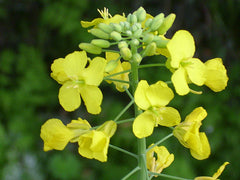Carum Carvi, Caraway
Caraway is a well-known herb that has been cultivated for its culinary and medicinal uses since ancient times. It is frequently cultivated in the modern herb garden and sometimes also commercially.
Plants growing in more northerly latitudes and also in full sun are richer in essential oils and therefore more aromatic. Plants strongly resent root disturbance. They often self-sow freely when in a suitable location.
This species is deep rooted and is a good plant for breaking up the sub-soil on heavy, wet land. It dislikes growing near fennel or wormwood but is a good companion for most plants, especially those that are shallow-rooted.
The flowers attract parasitic wasps to the garden, these prey on aphids and so help to reduce populations of insect pests.
Caraway has a long history of use as a household remedy especially in the treatment of digestive complaints where its antispasmodic action soothes the digestive tract and its carminative action relieves bloating caused by wind and improves the appetite.
Succeeds in ordinary garden soil as long as it is not too wet in winter. Prefers a moist soil in full sun or partial shade.
Best sown in situ in late summer and early autumn. The seed can also be sown March/April in situ, though in areas with cool summers the plants might not produce a crop of ripe seeds. Plants are very sensitive to root disturbance and should not be transplanted.
Edible uses
Seed - raw or cooked. A spicy flavour, it is used as a flavouring in confectionery and bread, also as a flavouring in salads, vegetables etc.
It is high in protein and fat. The seed is often chewed after a meal in order to sweeten the breath and also to relieve heartburn after a rich meal.
Per 100g, the seed contains 333 calories, 10g water, 20g protein, 14.5g fat, 50g carbohydrate, 12.5g fibre, 6g ash, 689mg calcium, 568mg phosphorus, 16.2mg iron, 258mg magnesium, 17mg sodium, 1351mg potassium, 5.5mg zinc, 363 IU vitamin A, 0.383mg thiamine, 0.379mg riboflavin, 3.61mg niacin.
An essential oil from the seed is used as a flavouring in ice creams, candy, soft drinks etc. It is an essential ingredient of the liqueur kümmel.
Root - cooked. Used as a vegetable like parsnips. Stronger in taste than parsnips, but liked by many.
A delicious vegetable.
Leaves - raw or as a flavouring in soups etc. The young leaves are much less spicy than the seeds and are a good salad, having a mild parsley-dill flavour. They give an aromatic tang to salads.
Older leaves can be cooked as a spinach.
The crushed seeds are brewed into a tea. It has a soothing effect on the digestion.



![Photo By H. Zell (Own work) [GFDL (http://www.gnu.org/copyleft/fdl.html) or CC-BY-SA-3.0 (http://creativecommons.org/licenses/by-sa/3.0)], via Wikimedia Commons.](http://www.openpollinated.co.uk/cdn/shop/products/1_004b3955-f8d0-43fc-b01e-54973bd991f7_thumb.jpeg?v=1510586912)






